A while back, I helped someone pick out a garbage truck.
They were in a rush and chose one that looked good on paper. But a few weeks in, it was clear—it couldn’t handle the job.
That experience stuck with me.
Since then, I’ve spent years comparing truck types, testing what works, and learning what doesn’t.
This guide walks you through 7 types of garbage trucks. You’ll see how each one works, what it’s made for, and which job it fits best.
By the end, you’ll have a clear picture—and a better way to decide.
So let’s begin!
Quick comparison Table
Before we dive deep into each truck, here’s a quick look at how they compare. This table gives you a simple overview to spot key differences fast.
| Truck Type | Loading Method | Typical Volume (yd³) | Best For | Key Feature |
| Rear Loader | Manual (rear) | 12–32 | Bagged waste, bulky trash, tight areas | Simple compaction, low cost |
| Front Loader | Automated (front forks) | 20–40 | Commercial routes, repeated stops | In-cab control, overhead loading |
| Side Loader | Manual or automated (side arm) | 20–30 | Residential pickup, frequent stops | Side arm or manual bin handling |
| Roll-Off | Hoist and rail system | 10–40 | Heavy debris, construction waste | Detachable open-top containers |
| Grapple | Hydraulic claw arm | 12–20 | Tree limbs, storm debris, large objects | Boom arm for lifting oversized waste |
| Pneumatic Collection | Vacuum suction via pipes | 10–20 | Enclosed areas, underground waste systems | Contact-free, sealed waste collection |
| Composting (Organic Waste) | Manual or lift-assist | 15–30 | Food scraps, yard debris, compost routes | Sealed tank, leachate and odor control |
1. Rear Loader Garbage Truck
I remember the first time I watched a rear loader on a busy morning route. Bags flew in, the compactor roared, and within minutes, the truck was moving on. It wasn’t fancy—but it got the job done.
Rear loader garbage trucks are still one of the most common models used today. Waste is loaded from the back, compacted inside, and carried to a landfill or transfer station. They’re built for simplicity and reliability.
Capacity and Features
- Volume: 12 to 32 cubic yards
- Weight capacity: Up to 18,000 pounds
- Compaction ratio: 3:1 to 6:1
- Rear cart tippers (optional)
- Hydraulic control panels or joysticks
- Rear-view safety cameras
- Steel packer blades for durability
How It Works
Waste is loaded into the rear of the truck by hand or with cart tippers. Once inside, a hydraulic blade moves the waste forward and compresses it tightly against the back wall. As new waste comes in, the compactor continues to push and make room. When the truck is full, the rear door opens, and the entire load is pushed out for disposal. It’s a simple process that keeps the route moving.
Best For
- Daily trash collection
- Bulky items and bagged waste
- Areas with narrow streets or limited space
Who Should Use It
- Local waste service providers
- Independent haulers
- Teams handling mixed or oversized waste
- Operators looking for lower-cost trucks
- Crews working in older neighborhoods with limited access
Pros and Limitations
Rear loaders are tough, simple, and good for all kinds of waste. But they need more labor, move slower than automated trucks, and can wear down crews over time. Still, for many users, they’re worth it.
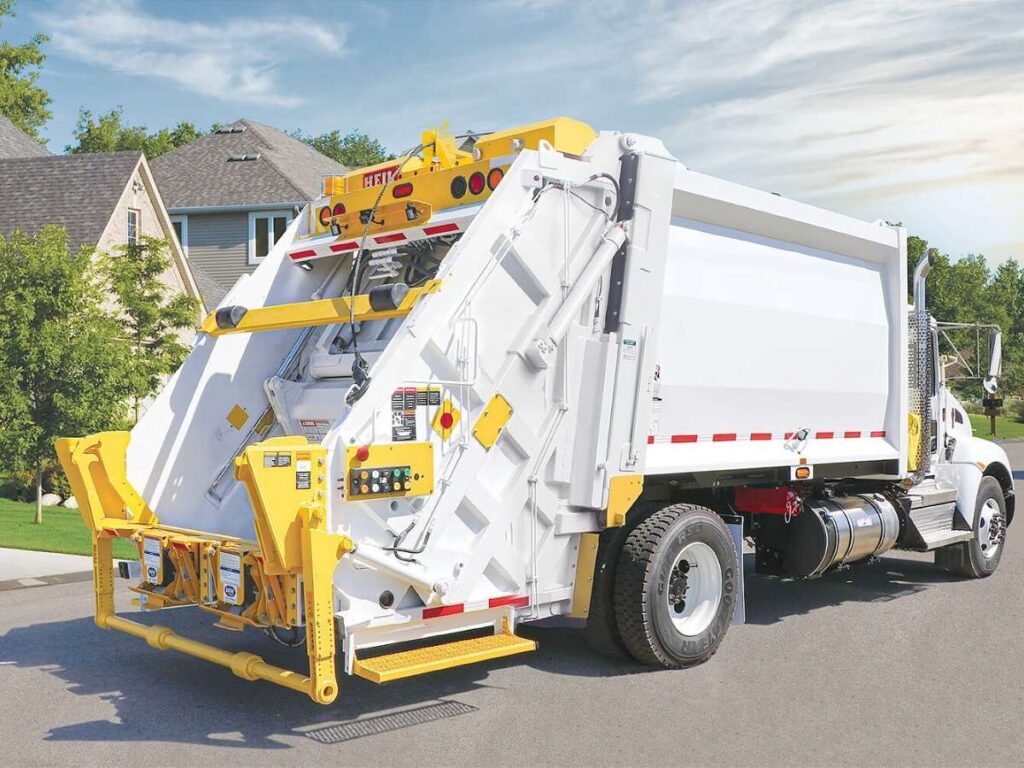
2. Front Loader Garbage Truck
You can spot a front loader with 2 long arms in front of the cab. With this truck, you stay inside while the machine does the lifting. It’s made for speed, large loads, and repeated stops.
A front loader garbage truck lifts containers overhead and dumps waste into a top-loading compartment. Everything happens from the cab. That makes it efficient—especially when you’re handling the same type of bin over and over.
Capacity and Features
- Volume: 20 to 40 cubic yards
- Weight capacity: Up to 8,000 pounds per container
- Compaction ratio: 4:1 to 6:1
- Hydraulic front forks for lifting large bins
- Top-loading hopper
- Enclosed body to control odor and mess
- Cab-controlled joystick or levers
- Rear ejection panel for quick unloading
How It Works
You line up with a container, hook it with the hydraulic arms, and lift it over the cab. The waste drops into the top of the truck body. Inside, a compactor pushes the load back, making space for more pickups. When the body is full, you drive to the dump site, open the rear gate, and eject the waste with a sweeping panel.
Best For
- Large container pickups
- Commercial waste routes
- Jobs needing fewer workers
- Fast and repeated stops
Who Should Use It
- Drivers working solo or on long shifts
- Waste companies with consistent bin sizes
- Routes with high volumes of trash
- Teams that prioritize speed and automation
- Users who want in-cab controls and less physical work
Pros and Limitations
You get high speed, less strain on workers, and fewer stops—but front loaders work best with uniform bins and cost more upfront. If your routes are consistent, it’s a smart and efficient option.
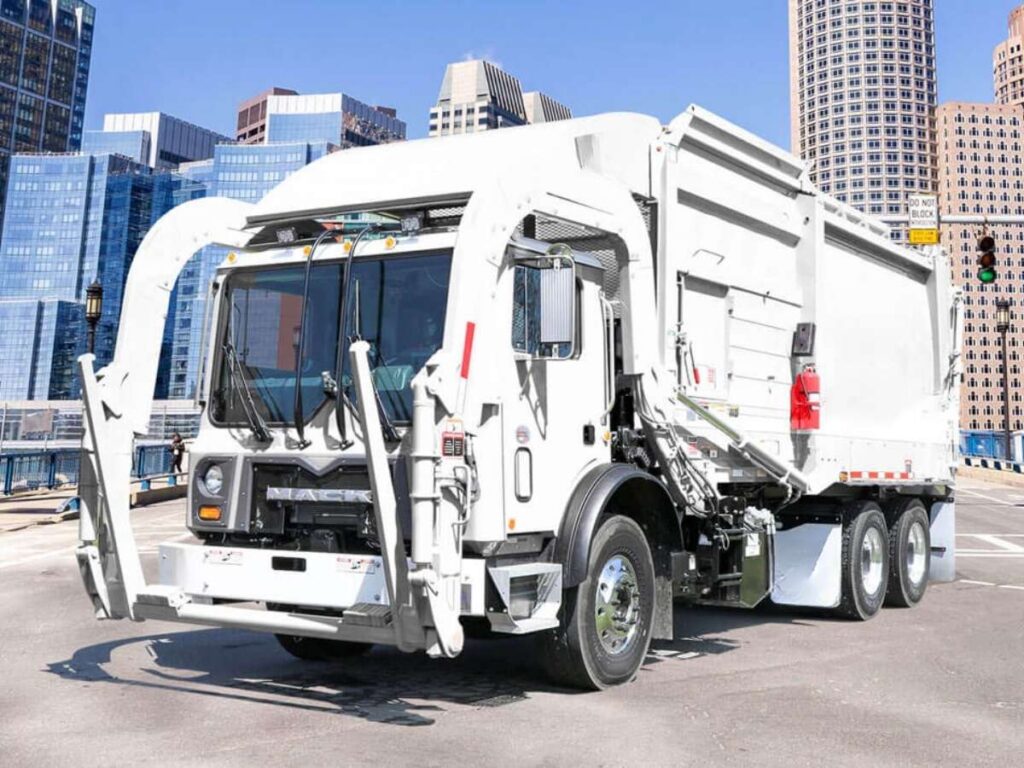
3. Side Loader Garbage Truck
If you want a garbage truck that lets you handle pickups alone, the side loader might be exactly what you need. With this design, you collect waste from the side of the truck—either manually or with an automated arm.
A side loader garbage truck gives you more control over how you collect and where you stop. It’s designed for speed, smaller crew sizes, and residential routes where bins are lined up curbside.
Capacity and Features
- Volume: 16 to 30 cubic yards
- Weight capacity: Around 6,000 to 10,000 pounds
- Compaction ratio: Around 3:1 to 5:1
- Automated arm (on some models) to grab bins
- Manual loading option on semi-automated models
- In-cab or side-mounted controls
- Lower hopper height for easier loading
How It Works
You drive along the curb, line up next to the bin, and either grab it manually or use the automated arm. Once the bin is lifted, the waste is dumped into a side hopper. A compactor inside the body pushes it back to make room for more. This setup keeps things moving, especially on tight streets with frequent stops.
Best For
- Residential waste collection
- Narrow streets and alleyways
- Jobs where bins are placed close to the curb
- Routes needing fewer crew members
Who Should Use It
- Operators who work solo or with just one helper
- Crews handling standard residential bins
- Municipal waste teams covering neighborhoods
- Users needing a compact truck with flexible loading
- Drivers working on short, frequent-stop routes
Pros and Limitations
Side loaders save labor, speed up curbside work, and are easy to operate—but they can struggle with oversized loads and may need frequent stops. If you want flexibility and fast pickups, this design works well for you.
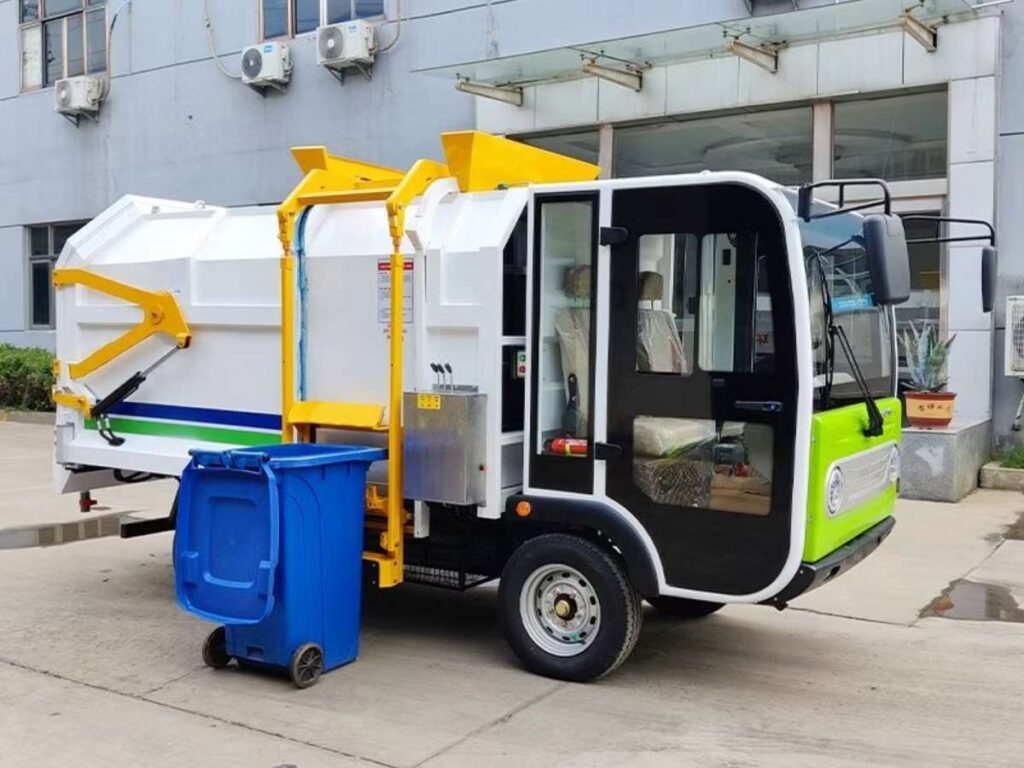
4. Roll-Off Garbage Truck
You hear the deep grind of steel rails, the rattle of chains, and the weight of a container hitting the truck bed. It’s heavy work—and that’s exactly what roll-off trucks are built for.
A roll-off garbage truck hauls large open-top containers, also called roll-off dumpsters. You load the container separately, and the truck picks it up using a hoist and cable system. It’s designed for big jobs—where trash isn’t just bags, but concrete, metal, or demolition waste.
Capacity and Features
- Container volume: 10 to 40 cubic yards
- Weight capacity: Up to 20,000 pounds or more
- Roll-on/roll-off rails for smooth container loading
- Hydraulic hoist system for lifting and lowering
- Cable or hook-lift mechanism
- Rear rollers to guide the container
- Tarp systems to keep debris contained on the road
How It Works
You start by backing up toward the container. The bed tilts, and the hoist pulls the container up using a steel cable or hook. You feel the truck shift slightly as the heavy box locks into place. Once loaded, you strap or tarp the top, hit the road, and haul it to a landfill or sorting site. To drop it off, you reverse the process—tilting the bed and letting the container slide off.
Best For
- Construction debris
- Demolition projects
- Large cleanouts or renovations
- Jobs that generate bulky, heavy waste
Who Should Use It
- If you deal with heavy loads and loose debris
- Contractors managing multiple job sites
- Operators hauling concrete, wood, or scrap metal
- Teams who need flexible container drop-offs
- Businesses working on short-term or seasonal projects
Pros and Limitations
You get serious hauling power and container flexibility—but roll-off trucks take more space, cost more to maintain, and need skilled drivers. If your job involves heavy-duty messes, this truck gives you the strength to handle it.
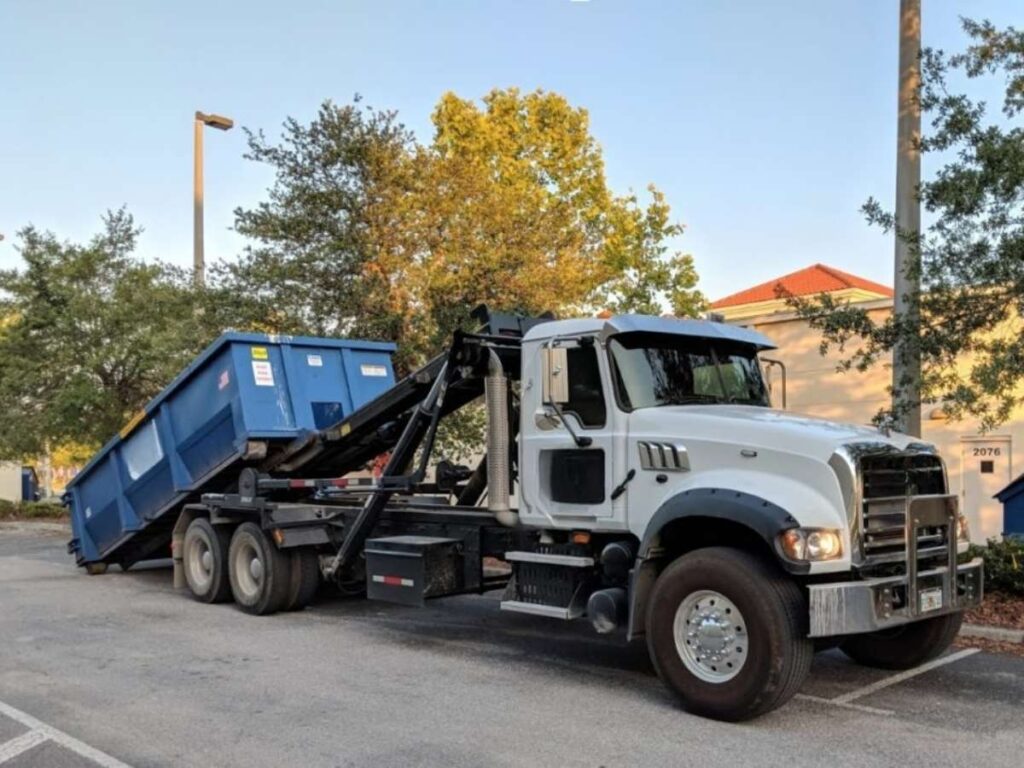
5. Grapple Garbage Truck
You watch the arm swing out like a mechanical claw. It lowers, grabs a tangled pile of tree limbs, and lifts it high into the air. There’s the hum of hydraulics, the snap of breaking branches, and the soft thud as it drops into the truck bed.
A grapple garbage truck uses a powerful hydraulic arm with a claw or grapple attachment to lift bulky or oversized waste. You don’t load by hand. The arm does the work—and it’s made for big, messy jobs.
Capacity and Features
- Volume: Typically 12 to 20 cubic yards
- Weight capacity: Often 10,000 to 16,000 pounds
- Hydraulic grapple arm with multi-directional control
- Knuckleboom design for flexible movement
- Open or enclosed bed depending on setup
- Optional dump body or container system
- Side-mounted or rear-mounted arm control station
How It Works
You position the truck near the waste pile, step into the control seat or use the side-mounted joystick, and guide the grapple. The arm swings, opens, grabs, and lifts. You hear the hiss of hydraulics and feel the machine respond under your fingertips. Once loaded, the bed may tilt or be emptied like a dump truck. It’s more physical to operate—but perfect for oversized, tangled, or heavy materials.
Best For
- Bulk waste pickup
- Storm cleanup and tree removal
- Large appliance or furniture collection
- Jobs where hand-loading isn’t practical
Who Should Use It
- You, if you handle bulky or scattered waste piles
- Crews managing cleanup after storms or floods
- Operators working in rural or wooded areas
- Businesses dealing with scrap, metal, or yard debris
- Teams needing extra reach and strength
Pros and Limitations
You get reach, power, and the ability to grab what other trucks can’t—but grapple trucks take up space, move slower, and need skill to operate. If you need control and muscle in one machine, this truck delivers both.
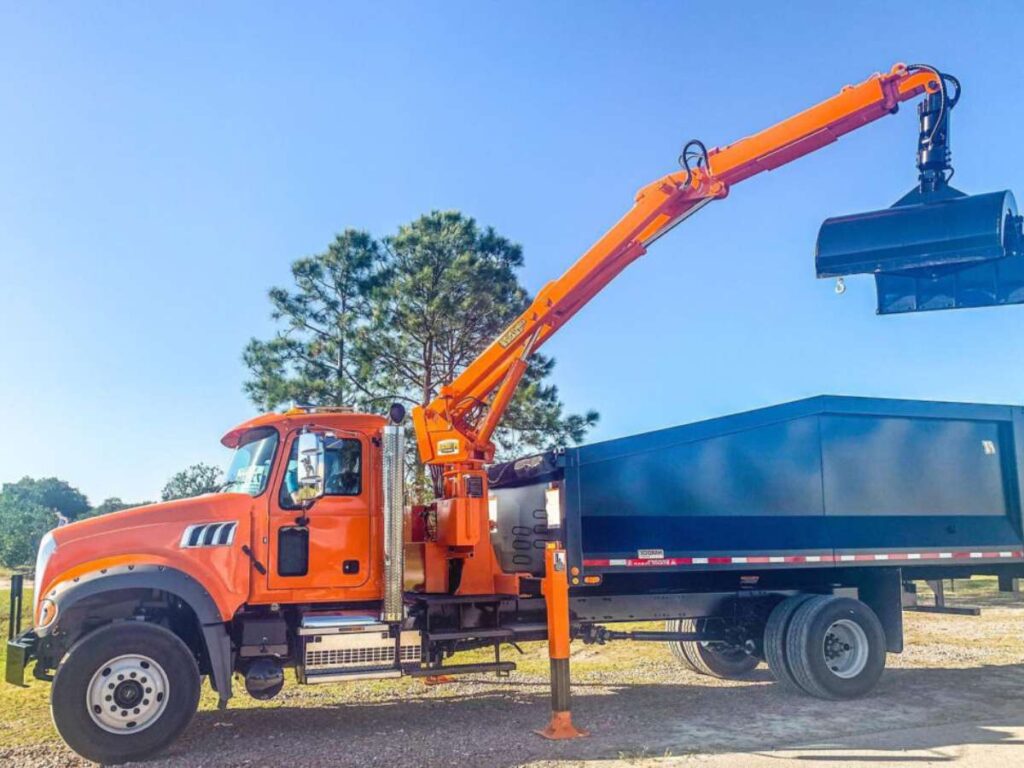
6. Pneumatic Collection Garbage Truck
“Is it even working?” I remember thinking the first time I watched a pneumatic truck in action. There were no bins banging. No trash being tossed. Just a quiet hum—and then, the waste was gone. Fast, sealed, and nearly silent.
A pneumatic collection garbage truck connects to underground pipes and uses vacuum pressure to pull trash directly into a sealed tank. It’s high-tech and designed for places that need clean, hidden waste removal without disruption.
Capacity and Features
- Volume: 10 to 20 cubic yards
- Weight capacity: Typically 8,000–12,000 pounds
- High-powered vacuum system
- Sealed containment tank
- Underground pipe connector or hose input
- Odor control and dust filters
- Low-noise motorized components
How It Works
The truck parks near a fixed waste station. A hose or pipe connects the truck to the building’s underground system. Once the system is pressurized, the vacuum kicks in—pulling trash through a sealed pipe and into the onboard tank. The process is fast, clean, and doesn’t require any lifting or manual sorting. After collection, the truck drives to a disposal site and empties the tank like a standard enclosed hauler.
Best For
- Enclosed, high-traffic areas
- Sites requiring odor and spill control
- Locations with fixed underground bin systems
- Properties that don’t allow visible waste pickup
Who Should Use It
- Airports and transit terminals
- Hospital and medical campuses
- Urban buildings with pneumatic waste networks
- Private facilities with underground trash chutes
- High-end residential zones using automated systems
Pros and Limitations
Pneumatic trucks offer clean, contact-free collection with almost no noise—but they only work where the infrastructure is already in place. For enclosed or sensitive areas, they’re one of the most efficient options available.
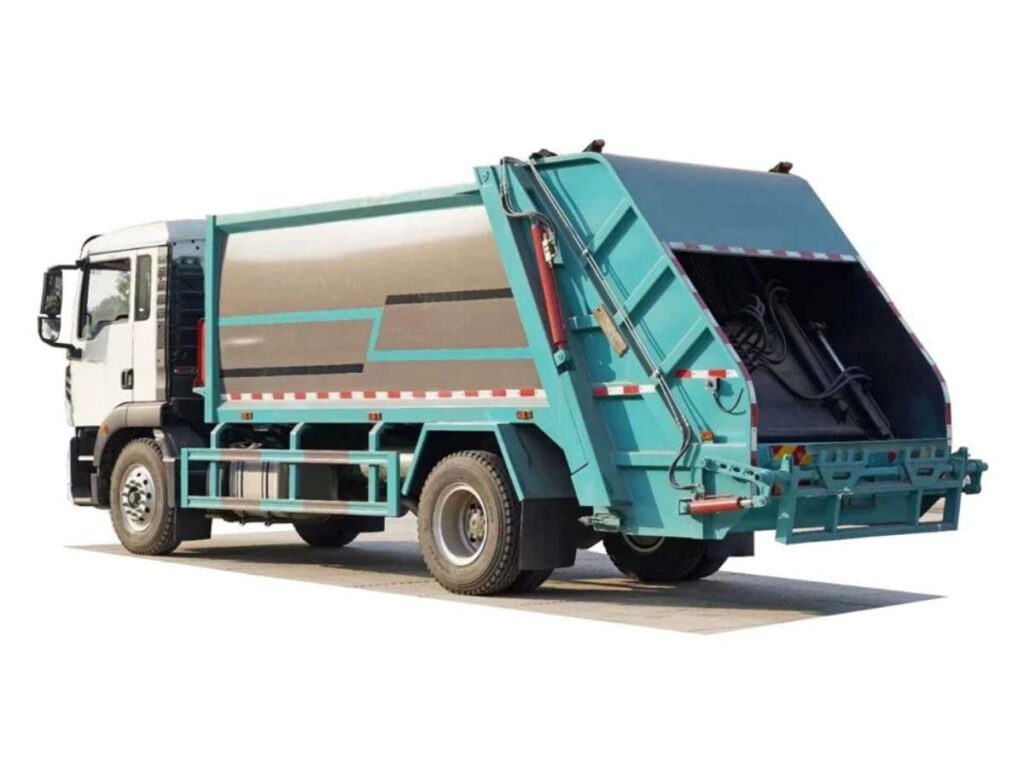
7. Composting (Organic Waste) Truck
The first time I rode along on a compost pickup route, I expected a regular trash day. But the smell was different. Earthy. Warm. You could see steam rising from the bins in the early morning cold. It wasn’t garbage—it was food scraps, leaves, and garden waste breaking down fast.
A composting truck is made to collect organic waste—things that rot and can be turned into compost. That includes food scraps, grass clippings, leaves, and other natural materials. It’s not for plastic or metal. Just pure, compostable waste.
Capacity and Features
- Volume: 15 to 30 cubic yards
- Weight capacity: Often 8,000 to 14,000 pounds
- Sealed body to trap moisture and odor
- Leachate collection tank (to catch liquid from organic waste)
- Aerated compartments to reduce smell
- Insulated body options for temperature control
- Onboard scales to monitor organic weight
How It Works
The truck stops at designated compost bins, often smaller and more frequent than regular trash bins. Waste is either lifted by an arm or loaded by hand. Because organic waste is heavier and wetter, the truck body is sealed to contain liquid and odor. Some models allow air to circulate to prevent early decomposition during transit. Once full, the load is delivered to a compost facility—not a landfill.
Best For
- Food waste collection
- Yard waste and landscaping routes
- Cities with composting programs
- Jobs focused on landfill reduction
Who Should Use It
- Municipal compost services
- Organic farms and eco-communities
- Large-scale restaurants or hotels
- Landscapers and garden centers
- Businesses separating food waste from trash
Pros and Limitations
Compost trucks help reduce landfill waste and support soil health—but they need careful handling, sealed containment, and access to composting sites. If you’re collecting what can break down and feed the earth, this is the truck that closes the loop.
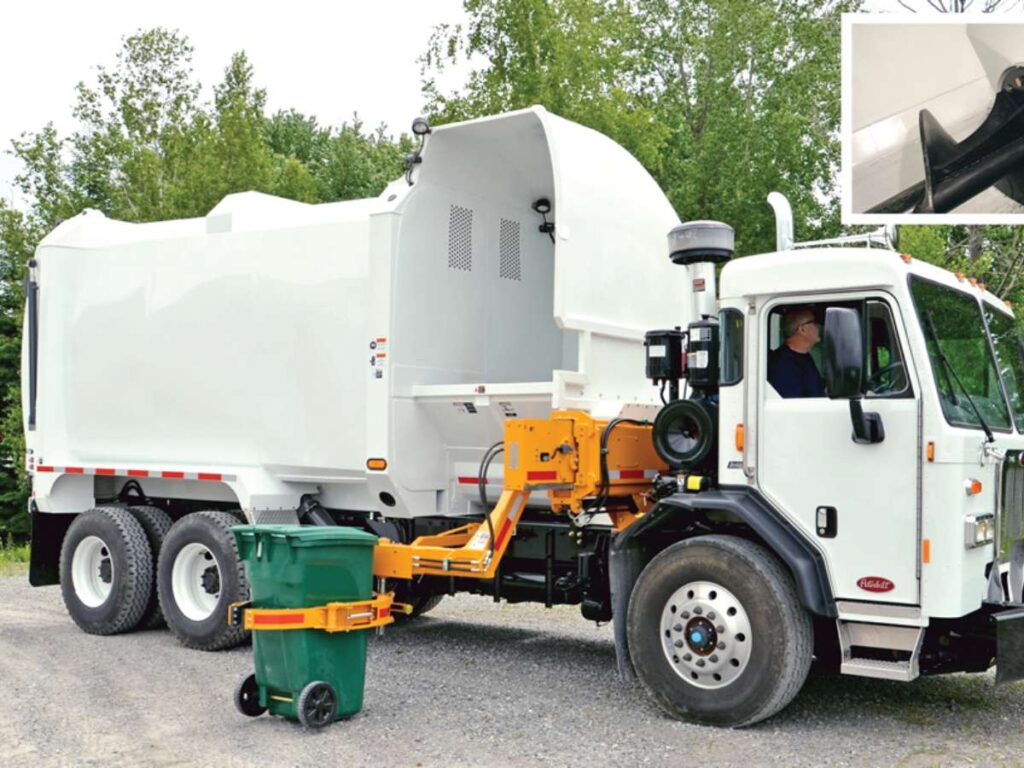
Conclusion
Each truck has its own strength, and now you know how to spot them. From collection style to capacity, you’ve got a clear overview to help match the right truck to the right job.
Whether you’re upgrading, expanding, or starting fresh, this guide gives you the clarity to move forward with confidence.
If you’re ready to take that next step, or even just talk through the options, we’re here.


